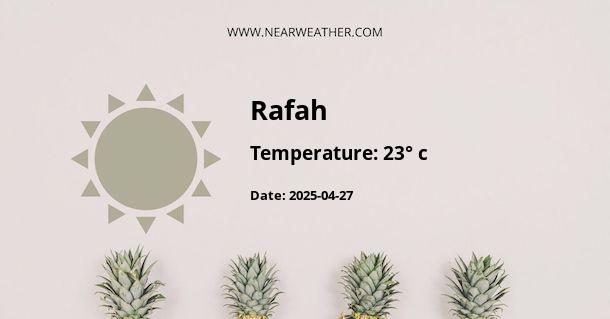Rafah, Palestine Weather and Climate
Rafah is a city located in the southern part of the Gaza Strip, Palestine. It is situated on the border with Egypt and experiences a Mediterranean climate. The weather in Rafah is characterized by mild winters and hot summers. In this article, we will explore the climate and weather patterns in Rafah throughout the year.
Temperature
The temperature in Rafah varies significantly between seasons. Summers are hot, with temperatures often exceeding 30 degrees Celsius (86 degrees Fahrenheit). The hottest months are July and August, with average high temperatures of around 32 degrees Celsius (90 degrees Fahrenheit). The nights are relatively cooler, with average lows of around 23 degrees Celsius (73 degrees Fahrenheit).
Winters in Rafah are mild, with average high temperatures ranging from 17 degrees Celsius (63 degrees Fahrenheit) in December to 20 degrees Celsius (68 degrees Fahrenheit) in February. The nights can be chilly, with average lows ranging from 9 degrees Celsius (48 degrees Fahrenheit) in December to 11 degrees Celsius (52 degrees Fahrenheit) in February.
Overall, Rafah experiences a warm climate throughout the year, with the summer months being particularly hot.
Precipitation
Rafah receives most of its rainfall during the winter months, between November and March. The wettest months are December and January, with an average precipitation of around 70-80 millimeters (2.8-3.1 inches) per month. The rest of the year is relatively dry, with very little rainfall.
Due to its location in the Mediterranean region, Rafah is influenced by the Mediterranean Sea, which brings occasional rainfall and moderates the temperature.
Wind
Rafah experiences moderate to strong winds throughout the year, with the strongest winds occurring during the winter months. The prevailing wind direction is from the northwest, blowing from the Mediterranean Sea towards the inland areas. These winds can occasionally reach speeds of up to 40 kilometers per hour (25 miles per hour).
Sandstorms
Rafah, like other areas in the Middle East, is prone to occasional sandstorms. These sandstorms are most common during the spring months, particularly in March and April. They are caused by strong winds blowing over the desert regions, picking up dust and sand particles and carrying them towards Rafah. Sandstorms can reduce visibility and affect air quality in the area.
Climate Data
Here is a table summarizing the average monthly temperature and precipitation in Rafah:
| Month | Average High (°C) | Average Low (°C) | Precipitation (mm) |
|---|---|---|---|
| January | 17 | 9 | 70 |
| February | 20 | 11 | 60 |
| March | 22 | 12 | 45 |
| April | 26 | 15 | 20 |
| May | 29 | 18 | 5 |
| June | 31 | 21 | 1 |
| July | 32 | 23 | 0 |
| August | 32 | 23 | 0 |
| September | 30 | 21 | 1 |
| October | 27 | 18 | 10 |
| November | 23 | 14 | 40 |
| December | 17 | 9 | 70 |
Conclusion
Rafah, Palestine, has a Mediterranean climate with hot summers and mild winters. The city experiences moderate winds throughout the year, with occasional sandstorms during the spring months. The winter season brings most of the rainfall, while the rest of the year is relatively dry. When planning a visit to Rafah, it is advisable to consider the temperature and weather conditions to ensure a comfortable and enjoyable experience.
A - Rafah's Latitude is 31.287001 & Longitude is 34.259521.
A - Weather in Rafah is 17° today.
A - Climate Conditions in Rafah shows clear sky today.
A - Humidity in Rafah is 81% today.
A - Wind speed in Rafah is 6.95 km/h, flowing at 312° wind direction. today.
